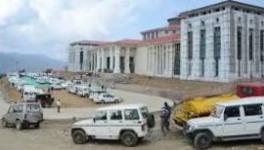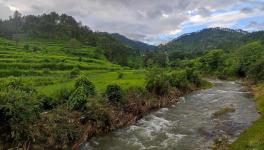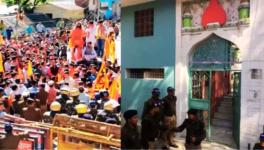NDMA Report Flags Joshimath’s Capacity, Recommends Construction Freeze

Image Courtesy: Wikimedia Commons
The National Disaster Management Authority (NDMA) has confirmed the observations of environmental scientists and experts regarding the ground subsidence in and around Joshimath town of Uttarakhand.
In a 130-page report titled ‘Post Disaster Need Assessment’ report on the town’s subsidence, the NDMA said that Joshimath “exceeded its carrying capacity” and recommended that the area be declared a “no-new construction zone”, The Times of India exclusively reported.
The report comprises eight reports on Joshimath prepared by key Central scientific and technical institutions accessed by the newspaper after the Uttarakhand High Court questioned the Pushkar Singh Dhami government for not making them public for several months.
“We see no reason that the state should keep the reports prepared by the experts secret and should not disclose the same to the public at large,” a division Bench comprising Chief Justice Vipin Sanghi and Justice Alok Kumar Verma said in an order on a PIL.
Uttarakhand High Court raises concerns over the secrecy surrounding Joshimath land subsidence reports, stressing the need for transparency and public access to vital information. #LandSubsidence #Uttarakhand #TransparencyIssueshttps://t.co/7uxXHITiyS
— The Telegraph (@ttindia) September 22, 2023
“In fact, circulation of the said reports would provide vital information to the public, and the public would have confidence in them that the state is serious about dealing with the situation,” the court said.
The Central Building Research Institute (CBRI), Geological Survey of India (GSI), Wadia Institute of Himalayan Geology, National Geophysical Research Institute (NGRI), Central Ground Water Board, Indian Institute of Remote Sensing, National Institute of Hydrology and IIT Roorkee had been asked to ascertain the causes of the ground and carry out remedial measures.
The eight institutions submitted their preliminary reports to the NDMA by January-end but were not made public. On September 20, the reports were placed in a sealed cover for the Court’s consideration.
The NDMA report reads: “Joshimath exceeded its carrying capacity, far beyond its capacity, and the area must be declared as a no-new construction zone.”
Joshimath’s population has increased from 16,709, as per the 2011 Census, to 25,000-26,000, according to the district administration.
The NDMA report -led team, meanwhile, pointed to possible negative impact on the environment from also said that large-scale future reconstruction activities in Joshimath. could impact the environment. “It is important that these reconstruction programmes focus on the use of green design, appropriate technologies and confined masonry,”.”
The CBRI’s 180-page report questioned the ongoing construction in Joshimath and recommended a review of the planning and development of the town and other hilly parts of the Himalayas.
The report stakeholders must know good construction typology, practice, material and regulatory mechanism based on geotechnical and geoclimatic conditions.
The CBRI also sought a plan for “phased de-densification of Joshimath and similar locations”.
The GSI report observed that the cracks were more prominent in densely populated areas and places with multistorey buildings like Manohar Bagh and Singhdhar.
“The heavy load exerted by a dense construction of towering structures over the heterogenous colluvium debris mass, which is saturated with shallow subsurface water, only accentuated the shear stress on the slope, thus increasing subsidence in these areas.”
The cracks were mostly aligned along a 50 metre-60 metre-wide linear array trending northwest-southeast of the town covering the densely populated Sunil village, Manohar Bagh, Singhdhar and Marwari wards.
After a detailed safety assessment of 2,364 buildings in Joshimath, the CBRI had found 20% of the houses “unusable”, 42% requiring “further assessment”, 37% “usable” and 1% as “needs to be demolished”.
The NGRI report said that certain areas of Joshimath “sunk vertically by over 3 feet and moved by 1.4 feet” with the fissures on barren and agricultural land as deep as 115 ft and become shallower and tangential at 60-65ft depth towards lower reaches of the subsidence-hit town”.
“Maximum horizontal displacement along the fissures were observed in Sunil, Manohar Bagh and Singhdhar with displacement as high as 45cm (1.4ft). Vertical displacement (sinking) as high as 110-110cm (3.6ft) was witnessed in Singhdhar and Marwari,” the NGRI report said.
The NDMA report also observed that the region is prone to high-magnitude earthquakes.
Joshimath has been divided into ‘red, black, yellow and green’ zones based on the magnitude of danger from subsidence, NDTV reported.
Joshimath Prone To High-Magnitude Earthquakes: Central Institutes https://t.co/KA8YKAw3t7 pic.twitter.com/glCURO4FkK
— NDTV News feed (@ndtvfeed) September 25, 2023
“All the construction in the high-risk zone in Joshimath will be demolished,” said Uttarakhand Disaster Management Department secretary Ranjit Sinha said.
The report gave a clean chit to the National Thermal Power Corporation (NTPC). Residents had complained to Dhami about the blasts in NTPC project tunnels.
Get the latest reports & analysis with people's perspective on Protests, movements & deep analytical videos, discussions of the current affairs in your Telegram app. Subscribe to NewsClick's Telegram channel & get Real-Time updates on stories, as they get published on our website.
























